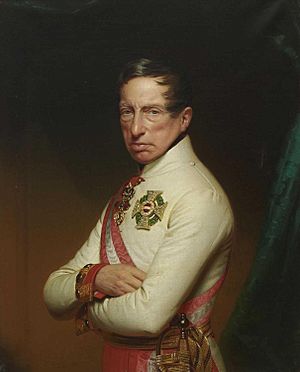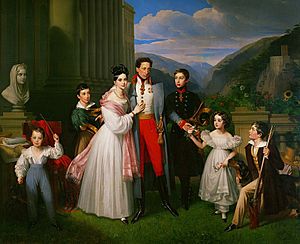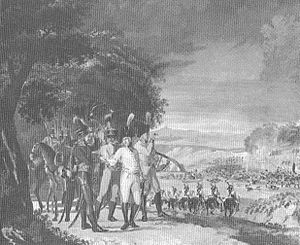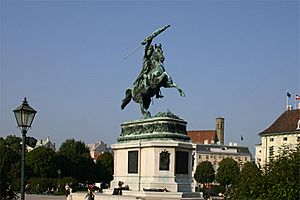Archduke Charles, Duke of Teschen facts for kids
|
||||||||||||||||||||||||||||||||||||||||||||||||||
Archduke Charles of Austria (born Karl Ludwig Johann Josef Lorenz von Österreich, Herzog von Teschen; 5 September 1771 – 30 April 1847) was an important Austrian military leader. He was the third son of Leopold II, Holy Roman Emperor and his wife, Maria Luisa of Spain. He was also the younger brother of Francis II, Holy Roman Emperor.
Even though he had epilepsy, Charles became a respected commander and helped improve the Austrian army. Many saw him as one of Napoleon's toughest opponents and one of the best generals during the French Revolutionary Wars.
He started his military career fighting against the French revolutionary armies. In 1793, he won at the Battle of Neerwinden. Later, in 1796, he led all Austrian forces on the Rhine river. There, he defeated French generals like Jean-Baptiste Jourdan and Jean Victor Marie Moreau in several battles. He also won battles at Zürich, Ostrach, Stockach, and Mannheim in 1799.
Charles worked to change Austria's armies, making them more modern. In 1809, he fought in the War of the Fifth Coalition. He gave Napoleon his first big defeat at the Battle of Aspern-Essling. However, he later lost the very bloody Battle of Wagram. After this, Charles did not fight in any more major battles during the Napoleonic Wars.
Contents
Early Life and Military Start
Charles was born in Florence, Tuscany. His father, who was the Grand Duke of Tuscany, allowed Charles's aunt Archduchess Maria Christina and her husband Albert of Saxe-Teschen to adopt him. They raised him in Vienna.
Charles spent his younger years in Tuscany, Vienna, and the Austrian Netherlands. This is where he began his military service during the French Revolutionary Wars. He led a group of soldiers at the Battle of Jemappes in 1792. In 1793, he showed his skill at the Action of Aldenhoven and the Battle of Neerwinden.
In 1793, he became the Governor of the Habsburg Netherlands. He lost this job when the French took over the Low Countries in 1794. That same year, he was promoted to lieutenant field marshal. Soon after, he became a Feldzeugmeister, which is like a Lieutenant General. He held important commands for the rest of the war in the Low Countries. He was also at the Battle of Fleurus (1794).
In 1795, he served on the Rhine river. The next year, he was put in charge of all Austrian forces there. How he managed the battles against Jean-Baptiste Jourdan and Jean Victor Marie Moreau in 1796 showed he was one of Europe's greatest generals. He carefully retreated at first, then left a small force to trick Moreau. He then attacked Jourdan, beating him in battles at Amberg (August), Würzburg, and Limburg (September). He forced Jourdan to retreat across the Rhine. Then, he turned to Moreau's army, defeating them and making them leave Germany after battles at Wetzlar, Emmendingen, and Schliengen.
Fighting in the Napoleonic Wars
In 1797, Archduke Charles was sent to stop General Bonaparte's successful march in Italy. He skillfully led the retreat of the Austrian army, which was outnumbered. In 1799, he again fought Jean-Baptiste Jourdan. He defeated Jourdan in the battles of Ostrach and Stockach. After these wins, he moved into Switzerland and defeated André Masséna in the First Battle of Zurich. He then returned to Germany and pushed the French back across the Rhine after winning at Mannheim in 1799.
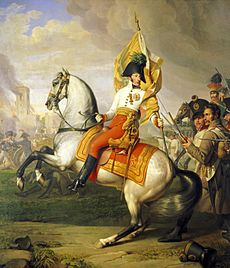
Victorious Archduke Charles of Austria during the Battle of Aspern-Essling (21–22 May 1809).
|
Due to poor health, he had to rest in Bohemia. But he was soon called back to stop Moreau's advance towards Vienna. However, the Battle of Hohenlinden had already decided the outcome. Archduke Charles had to agree to the armistice of Steyr, which was a ceasefire. He was so popular that in 1802, the Perpetual Diet of Regensburg wanted to build a statue for him and call him the "savior of his country." But Charles politely refused these honors.
In the short and difficult war of 1805, Archduke Charles led the main army in Italy. But the most important fighting happened in Germany. Austria lost battles on the Danube river, and Charles was defeated by Massena at the Battle of Caldiero. After peace was made, he started working hard to reorganize the army. These changes were first tested in battle in 1809.
In 1806, Francis II (who was now Francis I of Austria) made Archduke Charles the Commander in Chief of the Austrian army. He also became the head of the Council of War. Charles was respected because he was the only general who had managed to defeat the French. He quickly started big reforms to replace the old ways of the 18th century. The main changes were using the idea of a "nation in arms" (meaning everyone could be called to fight) and adopting French ways of organizing and fighting.
His army reforms were not fully finished by the war of 1809. Even so, the Austrian army was much stronger than before. It was only defeated after a very hard fight, which included Austrian victories and many lives lost on both sides.
The army's first successes were followed by losses at Abensberg, Landshut, and Eckmühl. But after Vienna was evacuated, the Archduke won a big victory at the Battle of Aspern-Essling. Soon after, he lost the Battle of Wagram after many soldiers died on both sides. At the end of the campaign, Archduke Charles left all his military jobs.
In 1808, when Napoleon made his brother Joseph king of Spain, Archduke Charles told his brother, Emperor Francis II, "Now we know what Napoleon wants - he wants everything."
Later Life and Family
When Austria joined the other countries against Napoleon in the War of the Sixth Coalition, Charles was not given a command. Instead, Prince of Schwarzenberg became the commander-in-chief of the main allied army. Charles spent the rest of his life retired from military service. He only returned for a short time in 1815 as the military governor of the Fortress Mainz. In 1822, he became the Duke of Saxe-Teschen.
On 15 or 17 September 1815, in Weilburg, Charles married Princess Henrietta of Nassau-Weilburg (1797–1829). She was the daughter of Frederick William of Nassau-Weilburg and his wife Burgravine Louise Isabelle of Kirchberg.
Frederick William was the oldest surviving son of Karl Christian of Nassau-Weilburg and Princess Wilhelmine Carolina of Orange-Nassau. Wilhelmine Carolina was the daughter of William IV, Prince of Orange and Anne, Princess Royal and Princess of Orange. Anne was the oldest daughter of George II of Great Britain and Caroline of Ansbach.
Charles passed away in Vienna on 30 April 1847. He is buried in tomb 122 in the New Vault of the Imperial Crypt in Vienna. A statue of him on horseback was put up in his memory on the Heldenplatz in Vienna in 1860.
Military Legacy
Archduke Charles was a very skilled military leader. He was able to plan and carry out difficult and risky troop movements. His campaign in 1796 is often seen as almost perfect. He was also very good at moving troops during battles, whether in wide movements or in large groups. His skills were as good as almost any other leader of his time.
Even though he lost in 1809, it was partly because the French and their allies had many more soldiers. Also, his army was still new after his reforms. His ideas about war, which he wrote in books, were very important at the time. However, some of his ideas were considered a bit old-fashioned even in 1806. He believed in being very careful and that controlling important places was more important than defeating the enemy's army.
But in practice, Charles often ignored his own cautious advice, especially in 1796, and achieved great results. This shows a interesting difference between his theories and his actions. In his actions, he was very active and skilled, making him one of Napoleon's toughest opponents for a long time.
Creating the Austrian Staff System
Archduke Charles played a key role in creating the modern staff system for the Austrian army. A "staff" is a group of officers who help the main commander plan and manage military operations.
In 1796, Charles added his own ideas to existing rules for staff officers. He said that the Chief of Staff should think about all possible plans for operations, not just follow orders. On 20 March 1801, Feldmarschalleutnant Duka became the world's first peacetime Generalquartiermeister (Chief of Staff) for the army. This meant the Chief of Staff's job was now focused on planning and helping the commander during wartime.
On 1 September 1805, Archduke Charles created new rules for the staff. He divided the staff into three groups:
- 1) Political Correspondence (dealing with messages about politics)
- 2) The Operations Directorate (planning and gathering information)
- 3) The Service Directorate (managing supplies and military rules)
Charles explained the role of a modern Chief of Staff: "The Chief of Staff works closely with the Commander-in-Chief and is completely available to him. His work connects him to all parts of the army." He also said: "The Commander-in-Chief decides what should happen and how; his chief helper (the Chief of Staff) works out these decisions so that every soldier understands their task." These changes helped make the Austrian army more organized and effective.
Children
| Name | Birth | Death | Notes |
|---|---|---|---|
| Archduchess Maria Theresa of Austria | 31 July 1816 | 8 August 1867 | Married Ferdinand II of the Two Sicilies, had children. |
| Archduke Albert, Duke of Teschen | 3 August 1817 | 2 February 1895 | Married Princess Hildegard of Bavaria, had children. |
| Archduke Karl Ferdinand of Austria | 29 July 1818 | 20 November 1874 | Married Archduchess Elisabeth Franziska of Austria, had children. |
| Archduke Friedrich of Austria | 14 May 1821 | 5 October 1847 | Died without marrying. |
| Archduke Rudolph of Austria | 25 September 1822 | 11 October 1822 | Died as a baby. |
| Archduchess Maria Karoline of Austria | 10 September 1825 | 17 July 1915 | Married her first cousin Archduke Rainer of Austria. |
| Archduke Wilhelm Franz of Austria | 21 April 1827 | 29 July 1894 | Died without marrying. |
Honors and Awards
 Austrian Empire:
Austrian Empire:
- Knight of the Golden Fleece, 1790
- Grand Cross of the Military Order of Maria Theresa, in Diamonds, 1793
 Kingdom of Bavaria: Knight of St. Hubert, 1844
Kingdom of Bavaria: Knight of St. Hubert, 1844 Empire of Brazil: Grand Cross of the Southern Cross
Empire of Brazil: Grand Cross of the Southern Cross Kingdom of France: Grand Cross of the Legion of Honour
Kingdom of France: Grand Cross of the Legion of Honour Kingdom of Prussia:
Kingdom of Prussia:
- Knight of the Black Eagle, 4 October 1835
- Knight of the Red Eagle, 1st Class
 Russian Empire:
Russian Empire:
- Knight of St. Andrew
- Knight of St. Alexander Nevsky
- Knight of the White Eagle
- Knight of St. Anna, 1st Class
 Grand Duchy of Tuscany: Grand Cross of St. Joseph
Grand Duchy of Tuscany: Grand Cross of St. Joseph Two Sicilies:
Two Sicilies:
- Knight of St. Januarius
- Grand Cross of St. Ferdinand and Merit
 United Kingdom: Honorary Grand Cross of the Bath (military), 23 May 1834
United Kingdom: Honorary Grand Cross of the Bath (military), 23 May 1834
Books Written by Archduke Charles
- Principles of the Art of War for Generals (1806)
- Principles of Strategy Explained by the Description of the 1796 Campaign (1814)
- History of the 1799 Campaign in Germany and Switzerland (1819)
See also
 In Spanish: Carlos de Austria-Teschen para niños
In Spanish: Carlos de Austria-Teschen para niños


